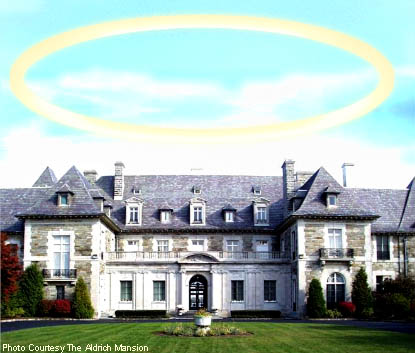Presents...
The Former 100 Million U.S. Dollar Residence of
Cardinal Law
Cardinal Law

For more detaisl from Forbes.com and by Betsy Schiffman read below...
If the Vatican allows the Archdiocese of Boston to file for bankruptcy in connection with the lawsuits it faces over sex abuse scandals, one thing is certain: Its vast real estate holdings will be used to make the settlement.
Since its early days, the Christian church has been one of the largest landowners in the world. This property traditionally includes not just churches and related structures, such as convents, bishops' palaces and schools, but also non-related structures and real estate.
It is unlikely that the Boston Archdiocese would literally go broke in connection with the $100 million sex abuse settlement. According to a report in The Boston Herald last August, it has about $160 million worth of income-producing commercial real estate and total property worth between $1.3 billion and $1.4 billion. As of 2001 the diocese boasted 2.069 million members. According to the Center for Applied Research in the Apostle (a national Catholic research center), each household puts an average $438 every year into the collection plate, which could generate hundreds of millions a year in total donations.
The threat of a bankruptcy filing could easily be a tactic to force lawyers for the accusers to accept a smaller settlement. In a similar case, the Archdiocese of Dallas, for example, managed to reduce a $100 million-plus settlement to $31 million after threatening to file for bankruptcy.
Given the huge influx of Catholics from Ireland and Italy that began in the 19th century, Boston is one of the biggest--and most land-rich--archdioceses in the U.S. However, because religious institutions are not compelled by law to divulge their investments or income, it is difficult for church outsiders to know with a great degree of accuracy the details of the church's finances.
Similar to charities and most nonprofit organizations, churches are tax-exempt, which means that unlike other residential landowners, they are not required to pay property taxes on their many mansions, retreats or land parcels. That doesn't apply, however, to commercial property not used for church purposes, nor does it apply to income that may be generated by commercial property (unless that income is used for church purposes, it gets taxed).
If the Boston Archdiocese is forced to settle, it seems likely that in any settlement the commercial property will help pay the costs. Those responsible for guiding the diocese's finances may be less likely to liquidate its real estate than to refinance or even issue mortgage-backed securities to pay its bills. Given the church's ties to local communities, and the recent scandals notwithstanding, it is likely that many local lenders will be able to provide the church the money it needs on favorable terms.
If the Vatican consents, the Boston Archdiocese would become the first American Roman Catholic diocese to file for bankruptcy. However, it is hardly alone in its cash crunch. Dioceses across the country, all of which may be land-rich and cash-poor, are counting pennies in order to pay sex abuse settlements.
Even dioceses that aren't in as much legal and financial trouble are sitting on large piles of real estate. The Archdiocese of Miami, for example, owns the titles to more than 100 pieces of property and has established several nonprofit real estate companies to manage the properties. Mary Ross Agosta, a spokeswoman for the Archdiocese of Miami, tells this anecdote: "In 1958, when the Archdiocese of Miami was first created, the Bishop [Coleman F. Carroll] would literally get into a small plane, fly around the state and say, 'We need to buy land there and there,' depending on where he felt the population would grow." (Agosta adds, however, that many of those properties are schools, nursing homes and so forth.)
Similarly, the Archdiocese of Providence in Rhode Island reportedly operates more than 220 corporate subsidiaries and $44 million worth of real estate, including the Aldrich Mansion, where the Brad Pitt movie Meet Joe Black was filmed. The Aldrich Mansion, built in 1896, sits on 75 acres on Narragansett Bay and was the setting for Abby Aldrich's 1901 wedding to John D. Rockefeller Jr.
In May, Cardinal Francis George of the Archdiocese of Chicago publicly said he might consider selling his mansion, a luxurious brick estate located in the upscale Gold Coast neighborhood, in order to raise funds to help pay for sex abuse lawsuits. The well-preserved property, built in 1885, is said to be worth well over $10 million, and it includes large landscaped gardens, 19 chimneys and a coach house, and has two entry facades. An archdiocese spokesman says the cardinal was just expressing his wish for a simple life and was not serious about actually selling the property.
In Boston it's not known whether Cardinal Bernard H. Law will be putting his mansion on the market. If the archdiocese declares bankruptcy, the property's fate will lie in the judge's hands.
Originally Published on March 19, 2002
 © Copyright 2002 - 2024 by The M+G+R Foundation. All rights reserved. However, you
may freely reproduce and distribute this document as long as: (1) Appropriate credit is given as
to its source; (2) No changes are made in the text without prior written consent; and (3) No
charge is made for it.
© Copyright 2002 - 2024 by The M+G+R Foundation. All rights reserved. However, you
may freely reproduce and distribute this document as long as: (1) Appropriate credit is given as
to its source; (2) No changes are made in the text without prior written consent; and (3) No
charge is made for it.
Online since 1998
Introduction for First Visit
Frequently Asked Questions
Home Page English Español Portugues
Search Page Index of Documents
Disclaimer About Us Contact
Back Up Home Page (Mirror Site)
Home Page English Español Portugues
Search Page Index of Documents
Disclaimer About Us Contact
Back Up Home Page (Mirror Site)